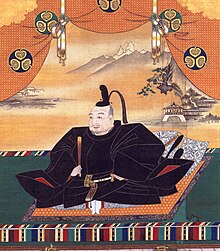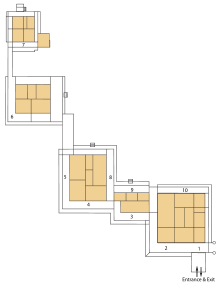Nijō Castle: Difference between revisions
Gryffindor (talk | contribs) →Honmaru Palace: add reference |
Gryffindor (talk | contribs) add info |
||
| Line 6: | Line 6: | ||
[[Image:Tokugawa 1.jpg|thumb|Tokugawa Ieyasu had the castle constructed]] |
[[Image:Tokugawa 1.jpg|thumb|Tokugawa Ieyasu had the castle constructed]] |
||
[[Image:Nijo Castle plan.svg|thumb|Present plan of Nijō Castle (click for detailed view)]] |
[[Image:Nijo Castle plan.svg|thumb|Present plan of Nijō Castle (click for detailed view)]] |
||
In [[1601]] [[Tokugawa Ieyasu]], the founder of [[Tokugawa Shogunate]] ordered all the [[Feudalism|feudal]] lords in Western [[Japan]] to contribute to the construction of the Nijō Castle. The construction was completed during the reign of [[Tokugawa Iemitsu]] in [[1626]]. It was built as the [[Kyoto]] residence of the [[Tokugawa Shogunate|Tokugawa Shoguns]]. The Tokugawa Shogunate used [[Edo]] as the capital city, but [[Kyoto]] continued to be the home of the [[Imperial Court in Kyoto| Imperial Court]] ([[Kyoto Gosho|Kyoto Imperial Palace]] is located north-east of Nijo Castle). |
In [[1601]] [[Tokugawa Ieyasu]], the founder of [[Tokugawa Shogunate]] ordered all the [[Feudalism|feudal]] lords in Western [[Japan]] to contribute to the construction of the Nijō Castle. The construction was completed during the reign of [[Tokugawa Iemitsu]] in [[1626]]. Parts of [[Fushimi Castle]] such as the main tower and the Kara Gate (''Kara-mon'', today main visitors entrance) were moved here in 1625-26.<ref>Schmorleitz, pg. 82</ref> It was built as the [[Kyoto]] residence of the [[Tokugawa Shogunate|Tokugawa Shoguns]]. The Tokugawa Shogunate used [[Edo]] as the capital city, but [[Kyoto]] continued to be the home of the [[Imperial Court in Kyoto| Imperial Court]] ([[Kyoto Gosho|Kyoto Imperial Palace]] is located north-east of Nijo Castle). |
||
The central keep or [[donjon]] was struck by lightning and burned to the ground in [[1791]]. |
The central keep or [[donjon]] was struck by lightning and burned to the ground in [[1791]]. |
||
| Line 24: | Line 24: | ||
[[Image:Nijojo-roka-tenjo2.jpg|thumb|Detail of the ceiling of Ninomaru Palace]] |
[[Image:Nijojo-roka-tenjo2.jpg|thumb|Detail of the ceiling of Ninomaru Palace]] |
||
[[Image:Ninomaru Palace Nijo Castle plan.svg|thumb|Map of the Ninomaru Palace (click for detailed view and explanation)]] |
[[Image:Ninomaru Palace Nijo Castle plan.svg|thumb|Map of the Ninomaru Palace (click for detailed view and explanation)]] |
||
The main access to the Ninomaru is through the Kara Gate, a court and the ''mi-kurumayose'' or "honourable carriages approach".<ref>Schmorleitz, pg. 82</ref> |
|||
The 3300 square meter Ninomaru Palace is built almost entirely of [[Hinoki cypress]]. The decoration includes lavish quantities of [[gold leaf]] and elaborate wood carvings, intended to impress visitors with the power and wealth of the [[shogun]]s. The sliding doors and walls of each room are decorated with wall paintings by artists of the [[Kanō school]]. |
The 3300 square meter Ninomaru Palace consists of five connected separate buildings and is built almost entirely of [[Hinoki cypress]]. The decoration includes lavish quantities of [[gold leaf]] and elaborate wood carvings, intended to impress visitors with the power and wealth of the [[shogun]]s. The sliding doors and walls of each room are decorated with wall paintings by artists of the [[Kanō school]]. |
||
The castle is an excellent example of social control manifested in architectural space. Low-ranking visitors were received in the outer |
The castle is an excellent example of social control manifested in architectural space. Low-ranking visitors were received in the outer regions of the Ninomaru, whereas high-ranking visitors were shown the more subtle inner chambers. Rather than attempt to conceal the entrances to the rooms for bodyguards (as was done in many castles), the Tokugawas chose to display them prominently. Thus, the construction lent itself to expressing intimidation and power to Edo-period visitors. |
||
The building houses several different reception chambers, offices and the living quarters of the shogun, where only female attendants were allowed. One of the most striking features of |
The building houses several different reception chambers, offices and the living quarters of the shogun, where only female attendants were allowed. One of the most striking features of the Ninomaru Palace are the "[[nightingale floors]]" (''uguisubari'') in the corridors. To protect the occupants from sneak attacks and assassins, the builders constructed the floors of the corridors in such a way as to squeak like birds when anyone walks on them. |
||
Some of the rooms in the castle also contained special doors where the shogun's bodyguard could come out and protect him. |
Some of the rooms in the castle also contained special doors where the shogun's bodyguard could come out and protect him. |
||
| Line 41: | Line 42: | ||
* Chokushi-no-ma (Imperial Messenger's Room) |
* Chokushi-no-ma (Imperial Messenger's Room) |
||
The Ōhiroma is the central core of the Ninomaru Palace and consists of four chambers: |
The Ōhiroma (Great Hall) is the central core of the Ninomaru Palace and consists of four chambers: |
||
* Ichi-no-ma (First Grand Chamber) |
* Ichi-no-ma (First Grand Chamber) |
||
* Ni-no-ma (Second Grand Chamber) |
* Ni-no-ma (Second Grand Chamber) |
||
| Line 47: | Line 48: | ||
* Yon-no-ma (Fourth Grand Chamber) |
* Yon-no-ma (Fourth Grand Chamber) |
||
as well as the Musha-kakushi-no-ma (Bodyguards' Chamber). |
as well as the Musha-kakushi-no-ma (Bodyguards' Chamber) and the Sotetsu-no-ma (Japanese fern-palm chamber). |
||
The back parts are the |
The back parts are the |
||
| Line 68: | Line 69: | ||
[[Image:Nijo Castle at night 2007-03-23.jpg|thumb|One of the castle's keeps]] |
[[Image:Nijo Castle at night 2007-03-23.jpg|thumb|One of the castle's keeps]] |
||
*[[Historic Monuments of Ancient Kyoto (Kyoto, Uji and Otsu Cities)]] |
*[[Historic Monuments of Ancient Kyoto (Kyoto, Uji and Otsu Cities)]] |
||
== References == |
|||
<!--per [[WP:GUIDE]], these sections are named Notes/References.--> |
|||
{{reflist}} |
|||
== Literature == |
== Literature == |
||
Revision as of 18:48, 16 August 2008


Nijō Castle (二条城, Nijō-jō) is a flatland castle located in Kyoto, Japan. The castle consists of two concentric rings of fortifications, the Ninomaru Palace, the ruins of the Honmaru Palace, various support buildings and several gardens. The surface area of the castle is 275,000 square meters, of which 8000 square meters is occupied by buildings.
History


In 1601 Tokugawa Ieyasu, the founder of Tokugawa Shogunate ordered all the feudal lords in Western Japan to contribute to the construction of the Nijō Castle. The construction was completed during the reign of Tokugawa Iemitsu in 1626. Parts of Fushimi Castle such as the main tower and the Kara Gate (Kara-mon, today main visitors entrance) were moved here in 1625-26.[1] It was built as the Kyoto residence of the Tokugawa Shoguns. The Tokugawa Shogunate used Edo as the capital city, but Kyoto continued to be the home of the Imperial Court (Kyoto Imperial Palace is located north-east of Nijo Castle).
The central keep or donjon was struck by lightning and burned to the ground in 1791.
In 1788 the Inner Palace was destroyed by a city-wide fire. The site remained empty until it was replaced by a prince's residence transferred from the Kyoto Imperial Palace in 1893.
In 1867 the Ninomaru Palace was the stage for the declaration by Tokugawa Yoshinobu, returning the authority to the Imperial Court. Next year the Imperial Cabinet was installed in the castle. The palace became imperial property and was declared a detached palace. During this time, the Tokugawa hollyhock crest was removed wherever possible and replaced with the imperial chrysanthemum.
In 1939 the palace was donated to the city of Kyoto and opened to the public the following year.
Fortifications

The Nijō Castle has two concentric rings of fortifications, both consisting of a wall and a wide moat. There is also a much simpler wall surrounding the Ninomaru Palace. The outer wall has three gates while the inner wall has two. In the southwest corner of the inner wall there are foundations of a five-storey keep, destroyed by a fire in 1750. The inner walls contain the Honmaru Palace with its garden. Between the two main rings of fortifications are located the Ninomaru Palace, Kitchens, Guard House and several gardens.
Ninomaru Palace



The main access to the Ninomaru is through the Kara Gate, a court and the mi-kurumayose or "honourable carriages approach".[2] The 3300 square meter Ninomaru Palace consists of five connected separate buildings and is built almost entirely of Hinoki cypress. The decoration includes lavish quantities of gold leaf and elaborate wood carvings, intended to impress visitors with the power and wealth of the shoguns. The sliding doors and walls of each room are decorated with wall paintings by artists of the Kanō school.
The castle is an excellent example of social control manifested in architectural space. Low-ranking visitors were received in the outer regions of the Ninomaru, whereas high-ranking visitors were shown the more subtle inner chambers. Rather than attempt to conceal the entrances to the rooms for bodyguards (as was done in many castles), the Tokugawas chose to display them prominently. Thus, the construction lent itself to expressing intimidation and power to Edo-period visitors.
The building houses several different reception chambers, offices and the living quarters of the shogun, where only female attendants were allowed. One of the most striking features of the Ninomaru Palace are the "nightingale floors" (uguisubari) in the corridors. To protect the occupants from sneak attacks and assassins, the builders constructed the floors of the corridors in such a way as to squeak like birds when anyone walks on them.
Some of the rooms in the castle also contained special doors where the shogun's bodyguard could come out and protect him.
The room sequence starting at the entrance is:
- Yanagi-no-ma (Willow Room),
- Wakamatsu-no-ma (Young Pine Room)
- Tozamurai-no-ma (Retainers' Room)
- Shikidai-no-ma (Reception Room)
- Rōchu-no-ma (Ministers' Offices)
- Chokushi-no-ma (Imperial Messenger's Room)
The Ōhiroma (Great Hall) is the central core of the Ninomaru Palace and consists of four chambers:
- Ichi-no-ma (First Grand Chamber)
- Ni-no-ma (Second Grand Chamber)
- San-no-ma (Third Grand Chamber)
- Yon-no-ma (Fourth Grand Chamber)
as well as the Musha-kakushi-no-ma (Bodyguards' Chamber) and the Sotetsu-no-ma (Japanese fern-palm chamber).
The back parts are the
- Kuroshoin (Inner Audience Chamber)
- Shiroshoin (Shogun's living quarters)
Honmaru Palace

The Honmaru Palace has a surface area of 1600 square meters. The complex has four parts: Living quarters, reception and entertainment rooms, entrance halls and kitchen area. The different areas are connected by corridors and courtyards. The architectural style is late Edo period. The palace displays paintings by several famous masters, such as Kanō Eigaku.
The Honmaru Palace was originally known as the Katsura Palace before relocated to the present site in 1893 and renamed. Originally the palace had 55 buildings, but only a small part was relocated. In 1928 the entronment banquet of the Showa Emperor was held here.[3]
Gardens

The castle area has several gardens and groves of cherry and ume trees. The Ninomaru garden was designed by the famous landscape architect and tea master Kobori Enshu. It is located between the two main rings of fortifications, next to the palace of the same name. The garden has a large pond with three islands and features numerous carefully placed stones and topiary pine trees.
The Seiryū-en garden is the most recent part of the whole Nijō Castle. It was constructed in 1965 in the northern part of the complex. It is intended as a facility for the reception of official guests of the city of Kyoto and as a venue for cultural events. Seiryū-en has two tea houses and more than 1000 carefully arranged stones.
See also

References
Literature
- Schmorleitz, Morton S. (1974). Castles in Japan. Tokyo: Charles E. Tuttle Co. pp. pg. 81-83. ISBN 0-8084-1102-4.
{{cite book}}:|pages=has extra text (help)
External links
![]() Media related to Nijō Castle at Wikimedia Commons
Media related to Nijō Castle at Wikimedia Commons
